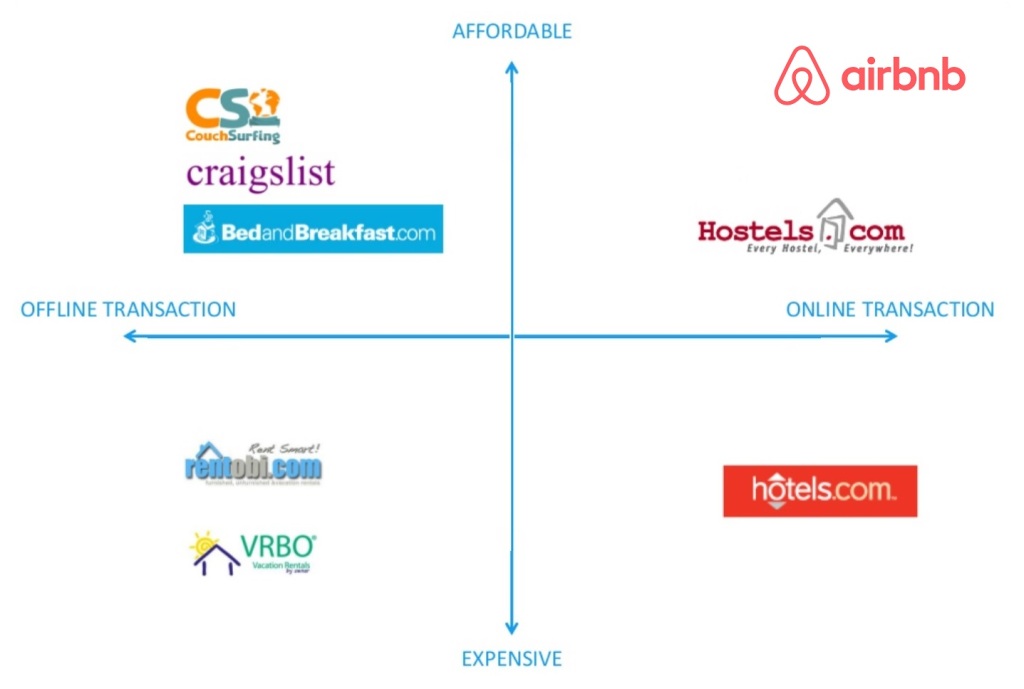Yeah, yeah, I know, you don’t have any competition. Your product is so revolutionary, there’s never been anything like it.
I hear that at least five times a day. Every entrepreneur says they have no competition. But you do. And frankly, the fastest way to lose credibility with investors is to tell us you have no competition. Because while you’re on the stage zooming through your pitch, we’re on our laptops looking up your competition. The first question during Q&A is often, “What about this other company I found that seems to be doing something similar.”
Even if you’re first to market and don’t have any direct competitors yet, you still have competition. Before AirBnB, businesspeople stayed in hotels, college kids crashed on couches, the rich relaxed at fancy B&B’s. There were websites for vacation rentals and short-term furnished apartments for extended business trips. Was AirBnB better? Absolutely! Did AirBnB have competition? Of course.
As investors, what we want to hear is not that you have no competition, but that you have some secret sauce that guarantees you’ll prevail over all of them, and ideally forces the giants to acquire you. It might be insights into customer needs based on your unique experience, or a better team, or key patents, or the industry giants trapped by inertia and technical debt of their aging products. In other words, you need a moat to beat the competition, but that’s different from not having competition.
So let’s talk about the competition slide. It comes after you’ve described your product and market and is a critical part of the evidence section that proves you’ll be able to turn your great idea into a successful business. In other words, it fits in the middle of the presentation either just before or after the moat/IP slide.
There’s two standard ways to compare yourself to competitors: a 4 quadrants graph or a checkbox of features. You probably think you don’t fit well into either model, and you’re right—these models are simplistic and fail to capture the complexities of why your product is better than the others. As you assemble your pitch deck, you’re tempted to come up with a different kind of competition slide, or maybe just a set of bullet points. My advice is don’t. Find a way to fit into the 4 quadrants or checkbox template.

Like everything else in your pitch, your goal is not to give an exhaustive description of the business but to provide a ten minute summary of why investors should be interested in learning more. You have a lot to cover and only about a minute to blow away the competitive threat. If you stick with the two graphics investors see over and over, we can absorb the information at a glance. If you make up something new, it’s more difficult for us to follow. So good pitchers find a way to fit their story into the standard graphics, even if that loses some nuance. If we’re interested, we’ll bombard you with questions about the competition, and during the due diligence phase, we’ll prepare an extensive competitor analysis, but for the pitch, the high level overview is sufficient.
However, keeping it high level does not mean leaving out competitors, or giving anything other than a forthright assessment of the competitive space. We expect you have competition and want to understand how you’re better. During due diligence, we’ll reach out to every contact we have in your industry. If you claim to be the only company to be able to do something and we learn there’s two other competitors able to do the same thing, you’ve lost your credibility and the chance for investment.
Your claims about the state of the competition can be independently verified, and so rightly or wrongly, we tend to use that to assess the veracity of everything else in your pitch. If you appear to be inflating your strength compared to the competition, we’ll assume you’re doing the same about the size of the market, about your traction, about the strength of the team, and about your chances of success. Be confident, but instead of saying you have no competition or that they’re flailing, tell us how you plan to beat them.
In short, keep the competition slide of your pitch simple but honest. Then be prepared to go into gory depth about the competition during due diligence.
Subscribe to receive your weekly insights

